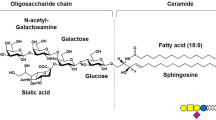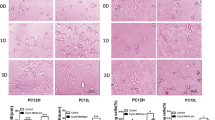Abstract
Our previous studies have shown that acidic glycosphingolipid, ganglioside GM1 (GM1), is an endogenous regulator of high affinity nerve growth factor receptor, Trk, which is an essential factor for the normal development and differentiation of neuronal cells by forming a complex with Trk. GM1 is also known to be a major constituent of caveola or glycosphingolipid-enriched microdomain (GEM) of the plasma membrane. In order to study the effect of the glycosylation of Trk on the formation of GM1-Trk complex and subcellular distribution of this protein, we generated PC12 cells stably overexpressing Trk (PCtrk). Pretreatment of this stable clones with tunicamycin, a potent inhibitor of N-glycosylation, caused the appearance of unglycosylated Trk core protein. These unglycosylated Trk can hardly respond to its ligand, NGF. Sucrose density gradient analysis revealed that unglycosylated Trk core protein was recovered in high density fractions, whereas most of GM1 is present in low density fractions corresponding to caveola or GEM fractions. Moreover, these unglycosylated Trk proteins lose their ability to form a complex with GM1, although GM1 is present in the same high density fractions. These data strongly suggest that spatial segregation of GM1 from the Trk protein by the inhibition of the glycosylation of Trk might be an important molecular mechanism for the unresponsiveness to NGF. Moreover, the binding site of GM1 in the Trk protein might act as an important determinant for the normal trafficking of the Trk protein within the cells.
Similar content being viewed by others
References
Bundgaard M, The three-dimensional organization of smooth endoplasmic reticulum in capillary endothelia: its possible role in regulation of free cytosolic calcium. J Struct Biol 107, 76–85 (1991).
Sveresn NJ, Caveolae: static inpocketing of the plasma membrane, dynamic vesicles or plain artifact. J Cell Sci 90, 341–8 (1988).
Anderson RGW, Caveolae: Where incoming and outgoing messengers meet. Proc Natl Acad Sci USA 90, 10909–13 (1993).
Parton RG, Simons K, Digging into caveolae. Science 269, 198–9 (1995).
Harder T, Simons K, Caveolae, DIGs, and the dynamics of sphingolipid-cholesterol microdomains. Curr Opin Cell Biol 9, 534–42 (1997).
Iwabuchi K, Handa K, Hakomori S, Separation of glycosphingolipid signaling domain from caveolin-containing membrane fraction in mouse melanoma B16 cells and its role in cell adhesion coupled with signaling. J Biol Chem 273, 33766–73 (1998).
Pitto M, Mutoh T, Kuriyama M, Ferraretto A, Palestini P, Masserini M, Influence of endogenous GM1 ganglioside on Trk B activity, in cultured neurons. FEBS Lett 439, 93–6 (1998).
Bilderback TR, Grigsby RJ, Dobrowsky RT, Association of p75(NTR) with caveolin and localization of neurotrophin induced sphingomyelin hydrolysis to caveolae. J Biol Chem 272, 10922–7 (1997).
Levi-Montalcini R, The nerve growth factor 35 y later. Science 237, 1154–62 (1987).
Kaplan DR, Martin-Zanca D, Parada LF, Tyrosine phosphorylation and tyrosine kinase activity of the trk proto-oncogene product induced by NGF. Nature 350, 158–60 (1991).
Kaplan DR, Hempsted BL, Martin-Zanca D, Chao MV, Parada LF, The trk proto-oncogene product: a signal transducing receptor for nerve growth factor. Science 252, 554–9 (1991).
Mutoh T, Tokuda A, Guroff G, Fujiki N, The effect of the B subunit of cholera toxin on the action of nerve growth factor on PC12 cells. J Neurochem 60, 1540–7 (1993).
Mutoh T, Tokuda A, Miyadai T, Hamaguchi M, Fujiki N, The ganglioside GM1 binds to Trk and regulate the receptor function. Proc Natl Acad Sci USA.
Mutoh T, Tokuda A, Inokuchi J, Kuriyama M, Glucosylceramide synthase inhibitor inhibits the action of nerve growth factor in PC12 cell. J Biol Chem 273, 26001–7 (1998).
Watson FL, Pocionatto MA, Bhattacharyya A, Stiles CD, Segal RA, TrkA glycosylation regulates receptor localization and activity. J Neurobiol 39, 323–36 (1999).
Jiang H, Ulme DSt, Dickenss G, Chabuk A, Lavarreda, Lazarovicci P, Guroff G, Both p140(trk) and p75(NGFR) nerve growth factor receptors mediate nerve growth factor-stimulated calcium uptake. J Biol Chem 272, 6835–7 (1997).
Hempstead BL, Rabin SJ, Kaplan L, Reid S, Parada LF, Kaplan DR, Overexpression of the trk tyrosine kinase rapidly accelerates nerve growth factor-induced differentiation. Neuron 9, 883–96 (1992).
Frooqui T, Franklin T, Pearl DK, Yates AJ, Ganglioside GM1 enhances induction by nerve growth factor of putative dimer of TrkA. J Neurochem 68, 2348–55 (1997).
Fra AM, Williamson E, Simons K, Parton RG, Detergentinsoluble glycolipid microdomains in lymphocytes in the absence of caveolae. J Biol Chem 269, 30745–8 (1994).
Barbosa-Tessmann IP, Chen C, Zhong C, Schuster M, Nick HS, Kilberg MS, Activation of the unfolded protein response pathway induces human asparagine synthetase gene expression. J Biol Chem 274, 31139–44 (1999).
Author information
Authors and Affiliations
Rights and permissions
About this article
Cite this article
Mutoh, T., Hamano, T., Tokuda, A. et al. Unglycosylated Trk protein does not co-localize nor associate with ganglioside GM1 in stable clone of PC12 cells overexpressing Trk (PCtrk cells). Glycoconj J 17, 233–237 (2000). https://doi.org/10.1023/A:1026597408790
Issue Date:
DOI: https://doi.org/10.1023/A:1026597408790




